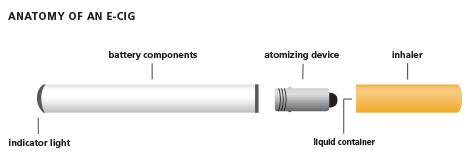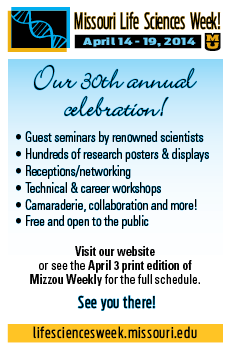The University of Missouri became a smoke-free campus July 1, 2013. Banned are cigarettes, cigars, pipes, hookahs, water pipes and e-cigarettes. The MU community is mostly abiding by the policy.
In recent months, however, a national debate has erupted about the good and the bad of e-cigarettes. The debate has not reached MU. But it could as the product’s popularity rises among young people and if e-cigarettes are recognized by the Food and Drug Administration as a cessation product like nicotine patches and lozenges.
Some experts say the product is a welcome alternative to tobacco cigarettes, linked to more than 400,000 deaths a year in the United States. Most e-cigarettes have nicotine, which offers a smoker’s high without the health-damaging tar of smoked tobacco. Also, because e-cigarettes emit no smoke, there is no health risk of secondhand smoke.
But others view e-cigarettes as a gateway to smoking tobacco and point out that they are currently unregulated and pose health risks. Moreover, “e-liquids,” their main ingredients, are a cocktail of neurotoxins that if ingested in their pure form — even through skin absorption — can cause serious illness and in rare cases death.
As for MU’s smoke-free policy, e-cigarettes were banned because of the confusion the products create due to their resemblance to tobacco cigarettes, said Tiffany Bowman, tobacco cessation coordinator for MU’s Wellness Resource Center.
“I believe this was a wise decision on the part of administration because we are still learning about the dangers of e-cigarettes, and we need a policy that is easily enforceable,” Bowman said.
The American Cancer Society, the American Lung Association and Americans for Nonsmokers Rights recommend smoke-free policies that include e-cigarettes.
E-attraction

Though on the American market for only seven years, e-cigarettes had national sales of $1.7 billion in 2013, more than double the sales in 2012, according to a Wells Fargo Securities study. Teenagers and young adults are finding them attractive, perhaps in part because celebrities like Zac Efron, Jenny McCarthy and Leonardo DiCaprio smoke them.
Over the last year, e-cigarette retail startups in America jumped four-fold. Columbia has three such stores: My Smokeless on Bernadette Drive and two Aqueous Vapor stores, one on Business Loop 70 and the other on Broadway, which opened in February.
Advertising of e-cigarettes recalls the smoking ads of the 1960s and ’70s that glamorized inhaling lit tobacco. On the My Smokeless website, a well-groomed man is shown in a tuxedo with a well-dressed lady on his arm as he holds an e-cigarette between his fingers. The message is clear: E-cigarettes mean sophistication and cool and contribute to being attractive to the opposite sex.
They also taste good. Liquid nicotine comes in a variety of sweet flavors, packaged by brands with provocative names like Seduce Juice, Jedi Juice and Buckshot. Buckshot sells a flavor called XXX, a mix of kiwi, mango and peach.
Health Issues
Some experts say the problems begin with the bottled liquid nicotine. The American Association of Poison Control Centers has labeled the liquid form toxic. Calls to poison control centers nationwide involving liquid nicotine hit 1,351 in 2013, with estimates this year being nearly 2,000 calls, according to the National Poison Data System.
Most e-liquid refill bottles are 10 mL, which is more than 10 times the expected lethal dose for a child, said Kevin Everett, MU associate professor of psychology and researcher of tobacco addiction and cessation programs.
In 2009, the FDA tested the ingredients of liquid nicotine and found levels of cancer-causing and toxic chemicals, including diethylene glycol, which is in antifreeze.
Angel Rolando Peralta, a pulmonary, critical care and environmental medicine fellow at University Hospital, said that subsequent studies confirmed toxicity in the e-cigarettes.
“However, the levels were much less than those present in cigarette smoke and also similar to those found in already FDA-approved nicotine replacement forms,” such as a nicotine patchs and inhalers, she said.
The vapor emitted is propylene glycol, which some health experts claim can irritate the lungs. But the ingredient is also used in hospitals, such as for inhaled medications, and is considered safe, said Rolando Peralta, who is writing a paper on e-cigarettes. There is also no evidence yet that e-cigarettes lead to smoking traditional cigarettes.
More studies need to be done, however, and there is concern about quality control of e-cigarettes since they are currently not regulated by the FDA, she said.
The health danger of traditional cigarettes stems from inhaling burning tobacco. It’s not the nicotine, though nicotine is addicting. But Everett points out that people who otherwise might have quit tobacco cigarettes will remain nicotine addicted by smoking e-cigarettes. This leaves them vulnerable to tobacco relapse or smoking both.
Cessation Device?
E-cigarettes’ best use might be as a smoke cessation, Rolando Peralta said. Their advantage over nicotine patches and lozenges could be that e-cigarettes also satisfy the behavioral rituals of tobacco smokers, she said.
But Everett doubts that e-cigarettes will be approved as a cessation device. “To date, I only have seen e-cigarettes positioned as an ‘alternative to smoking,’ ” Everett said. “I am not sure that the e-cig industry will go through the necessary studies to prove these devices as a cessation device.”

